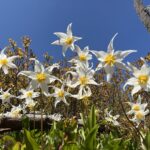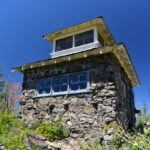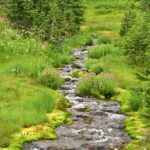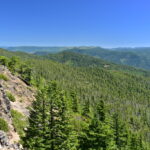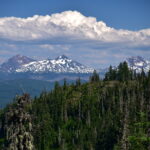Beargrass is an unusual wildflower that blooms in June and July. The white bulbs at the top of the 3-4′ high stalks are actually clusters of many tiny flowers. While beargrass plants are commonly seen at high elevations, they don’t actually bloom every year. There’s a common misconception is that it blooms every seven years, but the interval varies from place to place. For example, at Silver Star Mountain starting in 2006 (the first year I hiked there) the intervals have been three years, four years, two years, three years, three years, and four years.
A note about the term “superbloom“: many people use this in reference to a good beargrass display, but the term actually refers to an explosion of spring wildflowers in an arid region such as California or Arizona, following a period of above average precipitation.
Below are recommended hikes for seeing beargrass. Good bloom years for each hike were either seen by me, or I saw a report online. These aren’t necessarily comprehensive, and some good bloom years may be missing.
Silver Star Mountain

Hike description from the Silver Star Trailhead on the north
Hike description from the Grouse Vista Trailhead on the south
Good beargrass years: 2006, 2009, 2013, 2015, 2018, 2021, 2025
Three Corner Rock

Good beargrass years: 2009, 2025
Crescent Mountain

Photo credit: Greg Lief
Hike description
Good beargrass years: 2013
Umbrella Falls Loop

Good beargrass years: 2015, 2021, 2025
Blair Lake Trail

Good beargrass years: 2015, 2020
McIntyre Ridge

Good beargrass years: 2009, 2013, 2025
Patjens Lakes

Good beargrass years: 2013, 2025
Coffin Mountain

Good beargrass years: 2011, 2019
Hawk Mountain

Good beargrass years: 2013, 2023
Sourgrass Mountain
Good beargrass years: 2020, 2025
Bunchgrass Ridge
Good beargrass years: 2020
Paradise Park

Photo credit: Greg Lief
Good beargrass years: 2016, 2018
Olallie Mountain
Good beargrass years: 2020, 2025



